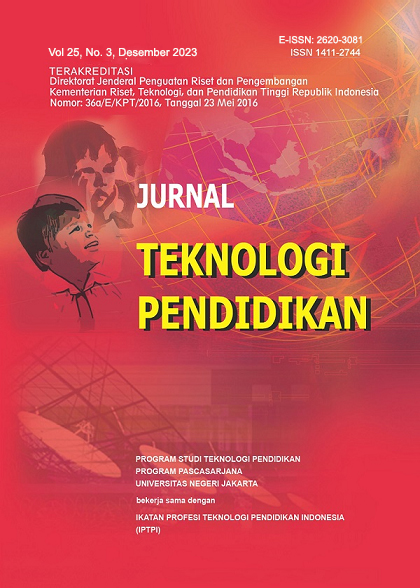Strategic Resource Relationship Model, Adaptability to Environmental Dynamics, Implementation of School-Based Management and Vocational School Competitiveness
DOI:
https://doi.org/10.21009/jtp.v25i3.48677Keywords:
strategic resources, environmental dynamics adaptability, implementation of school-based management, competitivenessAbstract
The aim of this research is to obtain the best relationship model between strategic resources, adaptability to environmental dynamics, and the implementation of school-based management on competitiveness in vocational schools which is thought to have an indirect relationship through existing mediating variables, without ignoring the direct relationship of each variable. This research is included in explanatory research with the statistical analysis technique used, namely Structural Equation Modeling (SEM). The population and sample in this study were 397 public and private vocational school teachers in East Java Province. Research data was collected through the distribution of questionnaires conducted online and offline. The results of hypothesis testing show that: (1) strategic resources have a positive and significant effect on environmental dynamics; (2) strategic resources have a positive and significant effect on the implementation of SBM; (3) adaptability to environmental dynamics has a positive and significant effect on SBM implementation; (4) strategic resources have a positive and significant effect on competitiveness; (5) SBM implementation has a positive and significant effect on competitiveness; (6) environmental dynamics have a positive and significant effect on competitiveness through the implementation of SBM; (7) strategic resources have a positive and significant effect on competitiveness through environmental dynamics and SBM implementation; (8) strategic resources have a positive and significant effect on competitiveness through the implementation of MBS; and (9) strategic resources have a positive and significant effect on the implementation of SBM through environmental dynamics.
References
Barney, J. (1991). Firm Reources ad Sustained Competitive Advantege. In Journal of Management (Vol. 17, Issue 1, pp. 99–120).
Ben Sassi, D., Frini, A., Ben Abdessalem Karaa, W., & Kraiem, N. (2016). A Competitive Intelligence Solution to Predict Competitor Action Using K-modes Algorithm and Rough Set Theory. Procedia Computer Science, 96, 597–606. https://doi.org/10.1016/j.procs.2016.08.240
Bordens, K., S. dan B. B. A. (2011). Research Design and Method; a Process Approach (8th ed). McGraw-Hill.
Boucher, G. (2011). Book Reviews: Book Reviews. Critical Sociology, 37(4), 493–497. https://doi.org/10.1177/0261018311403863
De Grauwe, A. (2005). Improving the quality of education through school-based management: Learning from international experiences. International Review of Education, 51(4), 269–287. https://doi.org/10.1007/s11159-005-7733-1
Deephouse, D. (2000). Media reputation as a strategic resource: an integration of mass communication and resource-based theories. Journal of Management, 26(6), 1091–1112. https://doi.org/10.1016/s0149-2063(00)00075-1
Grant, R. M. (2009). The resource-based theory of competitive advantage: Implications for strategy formulation. Knowledge and Strategy, December 1999, 3–24. https://doi.org/10.1016/b978-0-7506-7088-3.50004-8
Grant, R. M. (2010). Contemporary Strategy Analysis (7th ed). John Wiley and Sons Ltd.
Hardiansyah, F. (2022). The Implementation of School-Based Management in Improving Quality of Education in Primary School. Kelola: Jurnal Manajemen Pendidikan, 9(2), 148–162. https://doi.org/10.24246/j.jk.2022.v9.i2.p148-162
Mufidah, N. (2019). Strategi meningkatkan daya saing SMK Negeri 3 Batu jurusan broadcasting. http://etheses.uin-malang.ac.id/13525/
Palilingan, V. R., & Batmetan, J. R. (2019). Competitive Intelligence framework for Increasing Competitiveness Vocational High School Management. 299(Ictvet 2018), 230–233. https://doi.org/10.2991/ictvet-18.2019.52
Prilop, M., Tonisson, L., & Maicher, L. (2013). Designing Analytical Approaches for Interactive Competitive Intelligence. International Journal of Service Science, Management, Engineering, and Technology, 4(2), 34–45. https://doi.org/10.4018/jssmet.2013040103
Saunders, M., Lewis, P. and Thornhill, A. (2009). Research Methods for Business Students.
Siswantoyo, Suyanta, Fitrihana, N., Syauqi, K., Surwi, F., & Khurniawan, A. W. (2019). Daya Saing SMK Dalam Bursa Pasar Tenaga Kerja 4.0. Direktorat Pembinaan Sekolah Menengah Kejuruan Direktorat Jenderal Pendidikan Dasar Dan Menengah Kementerian Pendidikan Dan Kebudayaan, 1–232.
Solong, N. P., Munirah, M., & Arif, M. (2020). Effective School Management At Man Insan Cendekia Gorontalo. Lentera Pendidikan : Jurnal Ilmu Tarbiyah Dan Keguruan, 23(1), 22. https://doi.org/10.24252/lp.2020v23n1i3
Suhardi, A. (2017). PENINGKATAN MUTU PENDIDIKAN MELALUI MANAJEMEN BERBASIS SEKOLAH (MBS) Oleh: A. Suhardi Dosen STAIN Watampone. Adaara: Jurnal Manajemen Pendidikan Islam, 5(1), 374–385.
Triwiyanto, T., Kusumaningrum, D. E., & Juharyanto. (2017). Community Participation Deficits in the Implementation of School-Based Management in Indonesia. Journal of Education and Practice, 8(32), 67–74.
Yeap, C. F., Suhaimi, N., & Nasir, M. K. M. (2021). Issues, Challenges, and Suggestions for Empowering Technical Vocational Education and Training Education during COVID-19 Pandemic in Malaysia. Creative Education, 12(8), 1818–1839.
Zaid, Z. (2021). Implementation of School Based Management To Improve the Quality of Islamic Education At Mts Negeri 1 in Palu City. Risâlah, Jurnal Pendidikan Dan Studi Islam, 7(2), 356–367. https://doi.org/10.31943/jurnal_risalah.v7i2.196
Downloads
Published
How to Cite
Issue
Section
License
Copyright (c) 2023 Amidatus Sholihat Jamil, Waras Kamdi, Syamsul Hadi, Syaad Patmanthara

This work is licensed under a Creative Commons Attribution-ShareAlike 4.0 International License.
Jurnal Teknologi Pendidikan is an Open Access Journal. The authors who publish the manuscript in Jurnal Teknologi Pendidikan agree to the following terms.
Attribution-ShareAlike 4.0 International (CC BY-SA 4.0)
-
Attribution — You must give appropriate credit, provide a link to the license, and indicate if changes were made. You may do so in any reasonable manner, but not in any way that suggests the licensor endorses you or your use.
-
ShareAlike — If you remix, transform, or build upon the material, you must distribute your contributions under the same license as the original.
- No additional restrictions — You may not apply legal terms or technological measures that legally restrict others from doing anything the license permits.
Notices:
- You do not have to comply with the license for elements of the material in the public domain or where your use is permitted by an applicable exception or limitation.
- No warranties are given. The license may not give you all of the permissions necessary for your intended use. For example, other rights such as publicity, privacy, or moral rights may limit how you use the material.








